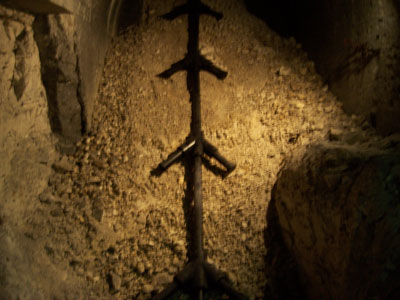
WWII: Maginot Line | Normandy | V-Weapon Sites | Arnhem
Further afield: Crete
| Home Tracing Military Ancestors Travel Advice CWGC Cemeteries Iron Harvest News Book Reviews Glossary Links Contact Me V-Weapon Sites:
 
|
V-3 Hochdruckpumpe (High Pressure Pump or HDP)The Nazis pursued a further "Vergeltungswaffe" during the Second World War to be specifically used against London. The "Hochdruckpumpe" or High Pressure Pump, as the weapon was known, was the brainchild of August Cönders, an engineer at Röchling Stahlwerk AG. In 1943 he proposed a fin-stabilised projectile that would be propelled up the gun barrel by multi-stage solid-fuel rocket accelerators. Seized upon by Albert Speer, Minister of Munitions, and championed by Hitler himself, prototypes were authorised with a view to, ultimately, bombard London with such rocket-assisted projectiles.
As testing and evaluation in Germany progressed, a site was chosen at Mimoyecques, in the Pas-de-Calais region behind Cap Gris Nez, to array 50 of these guns underground in limestone foundations. It was envisaged that each 150mm tube would fire 300 shells an hour against the inhabitants of London. It was a truly terrifying prospect and, needless to say, as soon as reconnaissance aircraft spotted the works in November 1943, the RAF and USAAF launched a series of devastating bombing raids against the facility. These culminated in a raid by the famed 617 "Dambusters" Squadron on 6th July 1944 when 12,000lb "Tallboy" bombs penetrated the underground complex causing sufficient damage for the Germans to abandon the works. Meanwhile, in Germany, the actual capabilities of the weapon were not matching the original vision. Difficulties were experienced in finding a suitable projectile and early versions of the gun lacked the muzzle velocity for the payload to reach London. Most serious of all, due to inadequate sealing of the projectile in the barrel, the propellant rockets often flashed the explosive chain reaction ahead of the charge. By the time these problems had been resolved, it was mid-1944 and time was running out for the deployment of the weapon. During test firings in May and July 1944, a range of only 55-58 miles could be attained - too short to reach London. It was in the last of these trials that the barrel of the test rig burst after firing 8 rounds. This ultimately finished the project. On 5th September 1944, the Mimoyecques site was captured by the Canadian 3rd Infantry Division following the Allies' breakout from the Normandy beacheads. The guns were only used once in anger, to bombard the city of Luxembourg in support of the Ardennes offensive in early 1945. |
